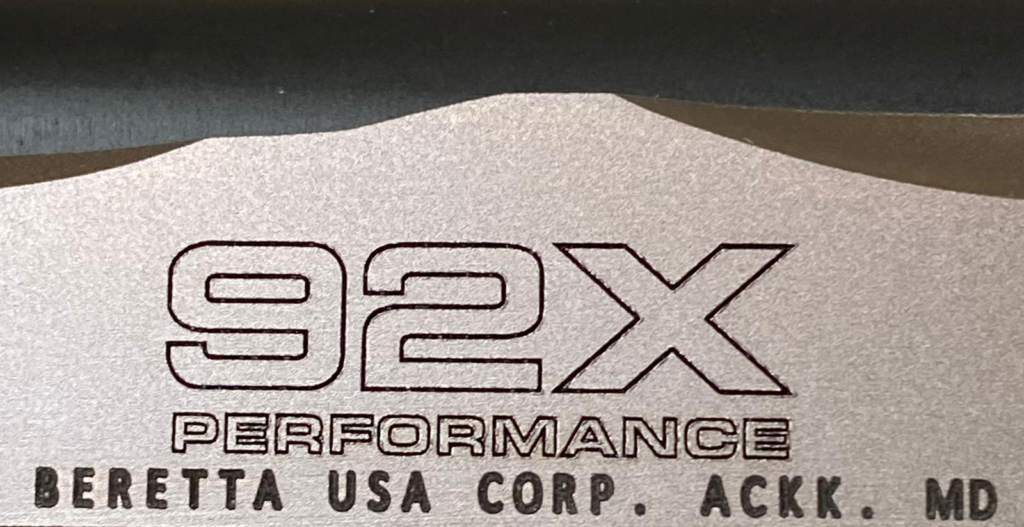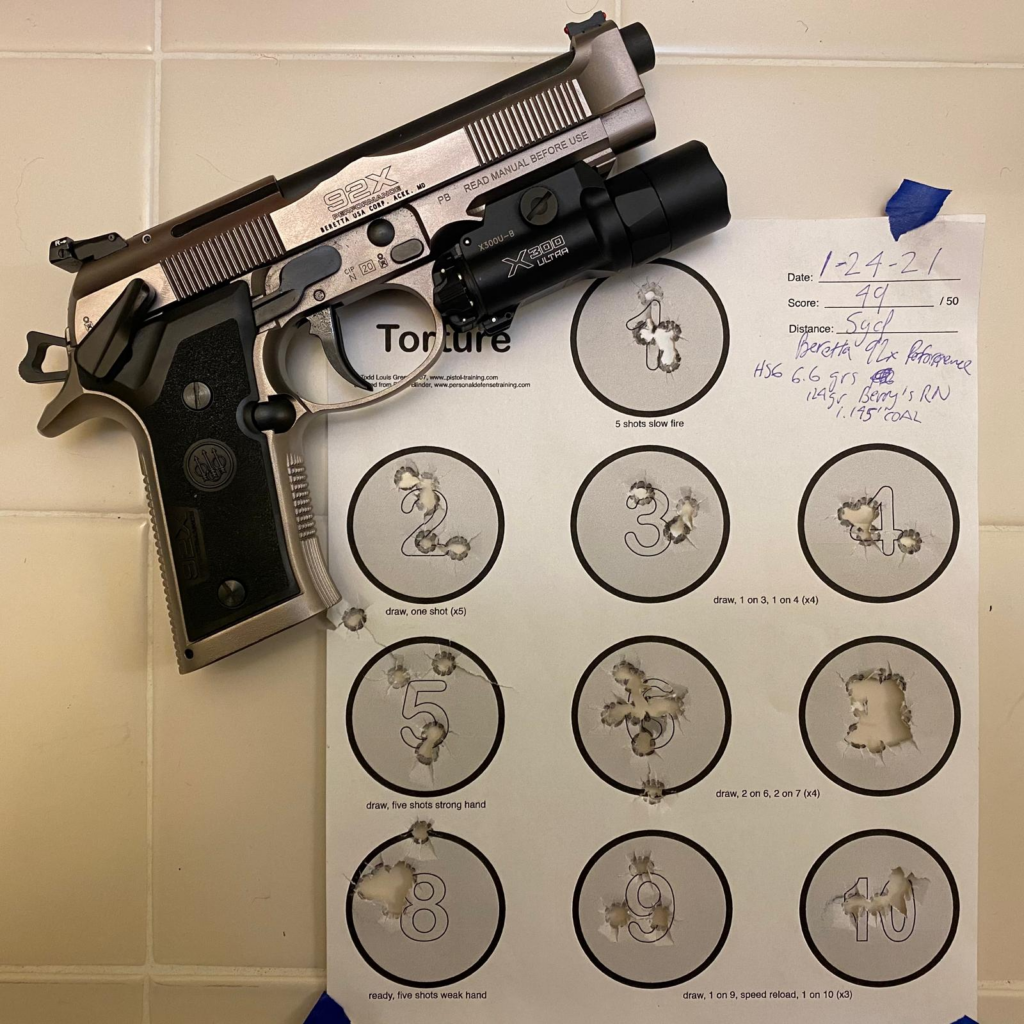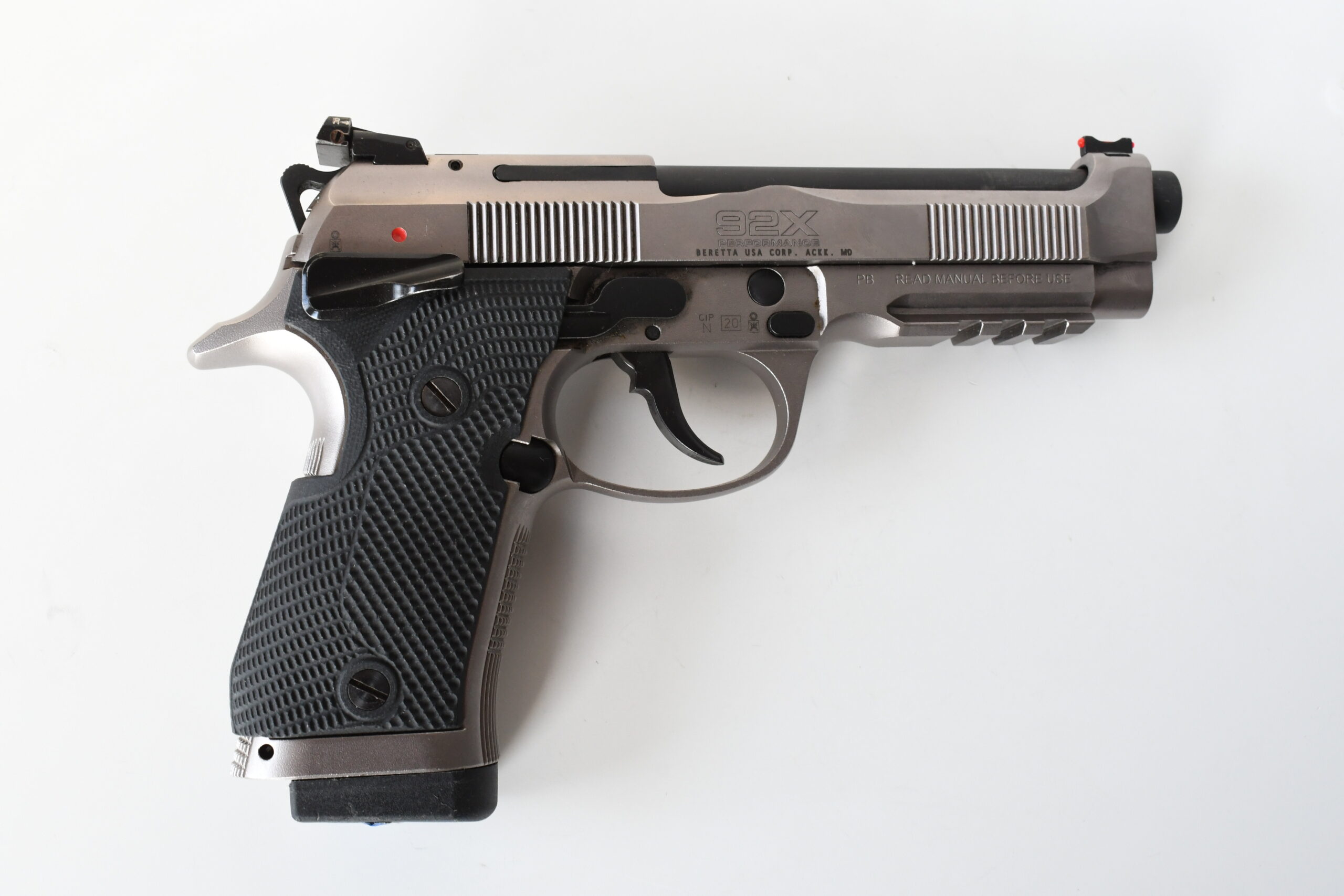My Beretta 92X Performance 9mm pistol, pictured in its current-day configuration with LOK wraparound Veloce grips.
In the autumn of 2020, I purchased a Beretta 92X Performance pistol. For the better part of two years after the purchase, that Beretta handgun became my go-to shooter. It was the gun I took to training classes and my gun of choice for USPSA. In fact, it was the gun that I was shooting when I first started to learn how action pistol matches worked in the first place.
Why Re-Hash the Beretta 92X Performance?
Even amongst all the handguns in my safe today, this Beretta is still one of my personally owned guns with a higher-than-average round count (by my own standards). Most importantly, it was the first handgun I ever reviewed in any way for any publication. You’re welcome to read that review here, and though I’m still content with my writing, it was an atypical review, to say the least.
Advertisement — Continue Reading Below
I was a brand-new writer and still getting a grasp on the craft. For fun, I’ve decided to write a “re-review” of my Beretta 92X Performance. Moreover, my pistol-shooting skills and understanding of handguns themselves have also evolved in tandem with my writing. Enough has changed, and it prompted me to try writing about this pistol again from my 2024 perspective.
I’ll also fully admit to hardly shooting my 92X Performance these days because I’m tied up shooting and writing other handgun reviews while also focusing on guns with dots. But it has been nice to pull it out of its spot from the safe and revisit it, like catching up with an old friend.

Advertisement — Continue Reading Below
500 Years, One Passion, and Atonement
On a personal level, the 92 series has always been something of a passion project for me. A few months ago, I also wrote another article related to the M9, and even though that project didn’t involve any range time, I really enjoyed drafting it because it served as a reminder of just how much I enjoy these guns.
The same is true of my “old” Beretta 92X Performance, which has gone by my wayside. It doesn’t have a dot, and it hasn’t been in any of my recent projects, either. However, it’s nice to be reminded of things one appreciates and just how much joy they used to bring, especially this [92XP0 one] because it’s a steel-framed Beretta 92.
For the longest time, steel-frame Beretta 92 models of any stripe were expensive, rare, and difficult to find. So when Beretta launched the 92X Performance in 2019 globally and made the gun more accessible to the masses, I and any other serious Beretta 92 enthusiast considered it a “big deal.”
Advertisement — Continue Reading Below
With that said, I’m also not blind to the fact that many of these guns produced during the COVID era had several reliability issues, especially in terms of firing, cycling, and quality control. I know this tainted the poor 92X Performance’s reputation, considering that the Beretta 92 pattern as an archetype is generally viable, extremely reliable, and proven.
Anecdotally, it appears to me that most of the guns with problems were made between 2021-2022. I’m under the impression that by this point in time, 2024, all of those kinks and issues have been handled because I haven’t heard any chatter about these since spring 2023. I also haven’t heard of any more issues from shooters at my club who use them, either.
Malfunction Free
Speaking from my experience shooting my own 92X Performance, which was manufactured at some point during 2020, I’ve never faced major issues or malfunctions. I’ve fired all manner of 9mm handloads and factory rounds. Across a few thousand rounds (between 3 to 5 thousand in my estimation), I’ve had only two seemingly random feedway stoppages, both from factory ammunition, ironically.
Advertisement — Continue Reading Below
Even so, these were so odd that I can’t rule out user error or the lube drying up. It is hard to diagnose stoppages in the middle of a USPSA stage when the timer is running, after all. In the grand scheme of things, along with my cumulative experience shooting Beretta 92s, these are insignificant.
Beretta 92X Performance Overview, Frame and Trigger
The Beretta 92X Performance is a full-size pistol chambered for 9mm Luger. It was created for sport shooting and employs a locking-block delayed blowback mechanism made famous by the German Walther P.38 military pistol. The 92X Performance is specifically manufactured and assembled in Italy and has Italian and European CIP proofmarks.

Advertisement — Continue Reading Below
Over the decades, Beretta has refined this semi-automatic locking block action and developed it into something quite reliable. The system also confers certain advantages over other contemporary designs, such as a very short and nearly horizontal path from the magazine’s feed lips into the chamber.
With locking blocks, barrels need not tilt, either. The tabs of the locking block will pivot and fall out, allowing the slide to travel to the rear and for the action to cycle.
This is one reason Beretta 92 slides are also nearly fully open from the top. There’s no need for material there. This also benefits the gun’s ejection, as there is hardly anything to block brass from flying out.
Advertisement — Continue Reading Below
Steel Frame
The 92 X Performance is built around a steel frame instead of the typical aluminum material that most Beretta 92 frames use. The heavier steel frame on this model weighs roughly a pound more than the aluminum units. But since it’s built for sport, the extra weight is advantageous in resisting the 9mm recoil impulse.
The result is a full-size pistol that’s extremely soft-shooting and easy to control in that sense. The trade-off is the heavier weight, which is certainly noticeable when the gun sits in a competition holster. Anyone who has worked with a CZ Shadow 2 will relate.
The steel frame on this model includes a practical Picatinny railed dustcover and a gently curved trigger guard that’s visually different from the typical 92 frame with the sharp corner. Unfortunately, the grip portion uses the cramped Beretta Vertec profile. I say, unfortunately, because this profile specifically leaves something to be desired and makes the gun feel like a “compact” (think CZ Shadow 2 Compact, Glock 19, etc.) in the hand, as opposed to the heavy and full-size pistol the 92X Performance truly is.
Advertisement — Continue Reading Below
In the same vein, its downward-angled beavertail is something I’m also not fond of. I find it gets in the way of building a solid grip quickly. While attractive, the Nistan finish on the frame has a tendency to feel somewhat slippery, even with the grips checkering. It’s noticeable when shooting during the hot and humid summer months.
On my pistol, it has also been susceptible to minor rust spots on the slide, especially during that hot and humid summer training and match season.
To Be Continued In Part 2
Advertisement — Continue Reading Below















